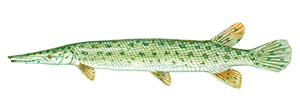Florida Gar

Species Details
Lepisosteus Platyrhincus
Lepisosteidae
Lepisosteiformes
Rivers, Tidal Mouths, Bends, Wrecks
3 - 9 lbs.
26" - 52"
Florida Gar (Lepisosteus Platyrhincus) Fish Description
The Florida Gar is are a mix between anguilliform and fusiform in shape with a tweezer-like snout. However, the Florida Gar has no dorsal fin but relies more on its several pairs of pectoral fins to move, which consists mostly of rays rather than spines. At the tip of each of its fins, one can see a faded bright yellow shade before it changes into dark brown (almost black) color towards the base. The Florida Gar also has a squared tail. Its mottled in black-brown with a burnt gold hue to separate the smears and spots. The belly is a bright white. However, the Florida Gar is known for being olive green on their back and upper sides.
A juvenile Florida Gar has dark stripes on the back and sides.
Florida Gar Diet and Size
Adult Florida Gars love eating fish, crayfish, and shrimp. Young Florida Gars prefer eating zooplankton and some insect larvae. They usually ambush their prey before thrashing their heads. Until finally, they place their prey in a position in which they can be swallowed whole.
Among the Gar species, the Florida Gar is considered medium-sized. Their average length reaches about 51.7 cm (20.4 inches) to 132.2 cm (52 inches). Typical weight is around 1.36 kg (3.0 lbs) to 4.36 kg (9.6 lbs).
Interesting Facts about the Florida Gar
- For reproduction, a female Florida Gar’s eggs are fertilized by multiple males.
- Florida Gars have an air bladder that helps them survive in poorly oxygenated water.
- Florida Gars burrow into wet areas during the dry season.
- This is a process known as aestivation.
- Florida Gars are not advisable to keep as pets.
- In some parts of the US, people need to secure a permit.
- Florida Gar and Long-nosed Gar look the same structure-wise but the Longnose Gar has no spots while the Florida Gar does.
Florida Gar – Fishing Techniques: How to Fish for a Florida Gar
While generally, anglers could catch Florida Gar with any hook. Some prefer using a single, treble, or a Kahle hook. They do this to tangle what appears to be the “beak” of the Florida Gar. However, other anglers have said that there are times you don’t need a hook at all. Some have used rope which was melted on one side then frayed on the other. After that, tie a wire to a swivel before casting it. Eventually, the Florida Gar will bite.
Florida Gar can be quite aggressive so it’s advisable to not reel it in right away. Some anglers even suggest letting the reel run first. Let the Florida Gar rampage for a bit until you feel that it's been entangled. Once you feel the hook’s set into the Florida Gar, begin reeling it. But take note, these fish are strong fighters and they will give you a good fight.
As for places to start, people have mentioned piers where anglers normally clean their fish. Florida Gar love feasting on the guts and entrails of dead fish. The moment you find a place, you can try casting your line for a Florida Gar. Plus, you get free bait. All you have to do is ask the anglers there for fish guts and entrails.
However, some Florida Gar may prefer going after live bait so best bring to some shrimp or live crayfish to hook them up.
Florida Gar Habitat and Distribution
Florida Gar like places with a lot of vegetation. At times, anglers can see them hanging amongst the weeds. Usually, they are found in canals, lowland streams, or muddy lakes. As long as there is vegetation that is around 4-10 feet deep, there’s bound to be Florida Gar even if the water body appears to be low in oxygen.







